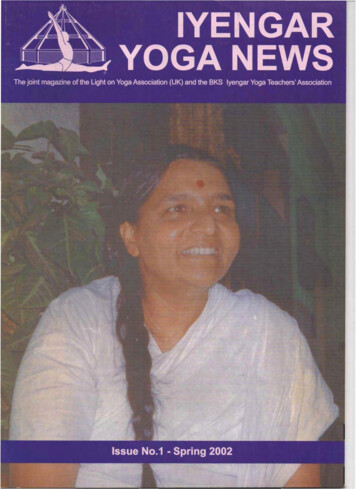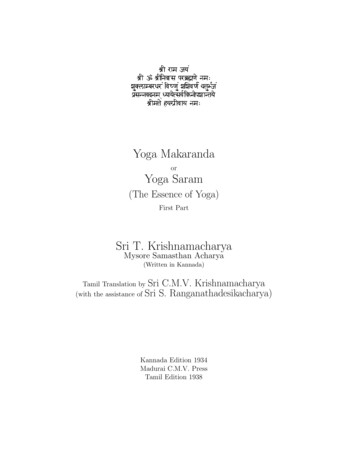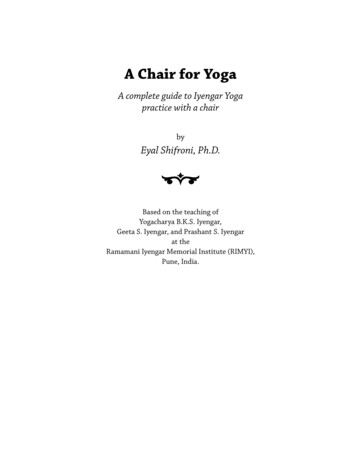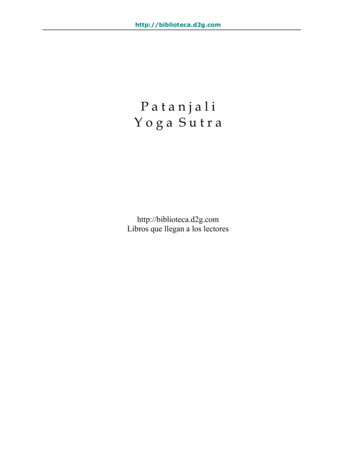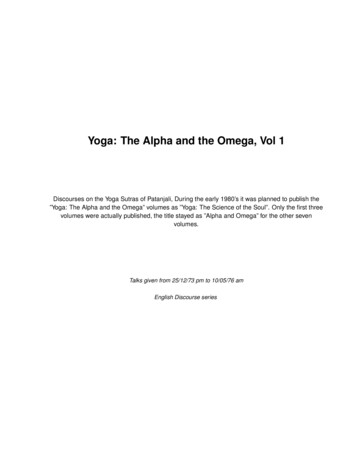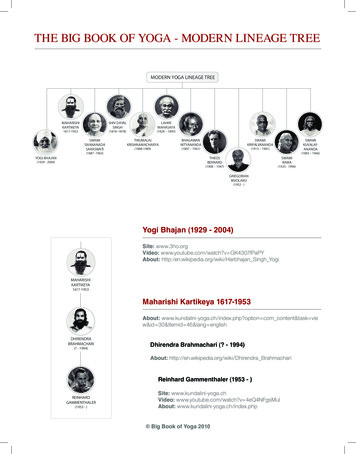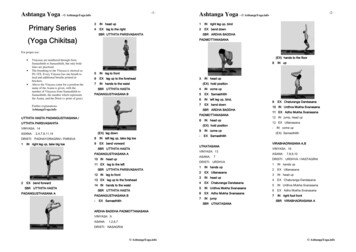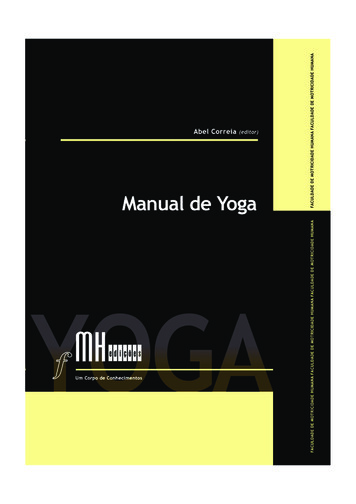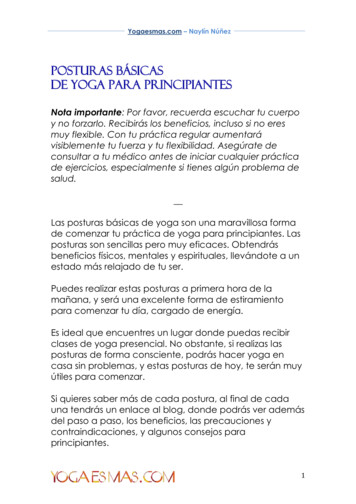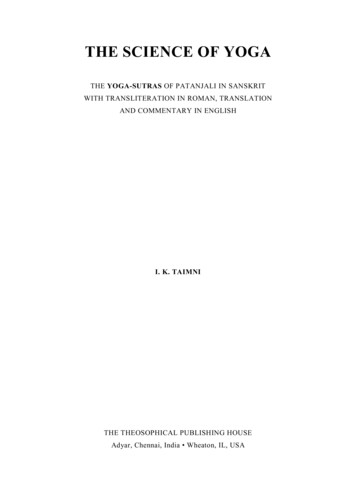
Transcription
THE SCIENCE OF YOGATHE YOGA-SUTRAS OF PATANJALI IN SANSKRITWITH TRANSLITERATION IN ROMAN, TRANSLATIONAND COMMENTARY IN ENGLISHI. K. TAIMNITHE THEOSOPHICAL PUBLISHING HOUSEAdyar, Chennai, India Wheaton, IL, USA
2PREFACEA large number of thougthful people, both in the East and the West, are genuinely interested in the subject of Yoga. This is natural because a man who has begun to question life and its deeper problems wants something more definite and vital for his spiritual needs than a mere promise of heavenly joys or ‘eternal life’ when he passes out ofhis brief and feverish life on this planet. Those who have lost faith in the ideals of orthodox religions and yet feel that their life is not a meaningless and passing phenomenon of Nature naturaly turn to the philosophy of Yoga for the solution of problemsconnected with their ‘inner’ life.People who take up the study of Yoga with the object of finding a more satisfactory solution of these problems are likely to meet with one serious difficulty. Theymay find the philosophy interesting, even fascinating, but too much enveloped in mystery and rigmarole to be of much practical value in their life. For there is no subjectwhich is so much wrapped up in mystery and on which one can write whatever onelikes without any risk of being proved wrong. To a certain extent this atmosphere ofmystery and obscurity which surrounds Yoga is due to the very nature of the subjectitself. The philosophy of Yoga deals with some of the greatest mysteries of life and theUniverse and so it must inevitably be associated with an atmosphere of profound mystery. But much of the obscurity of Yogic literature is due, not to the intrinsic profundity of the subject, but to the lack of correlation between its teachings and the factswith which an ordinary educated man is expected to be familiar. If the doctrines ofYoga are studied in the light of both ancient and modern thought it is much easier forthe student to understand and appreciate them. The discoveries made in the field ofScience are especially helpful in enabling the student to understand certain facts ofYogic life, for there is a certain analogous relationship between the laws of higher lifeand life as it exists on the physical plane, a relationship which is hinted at in the wellknown Occult maxim ‘As above, so below’.Some teachers of Yoga have attempted to meet this difficulty by taking out ofthe philosophy and technique of Yoga those particular practices which are easy to understand and practise, placing these before the general public as Yogic teachings. Manyof these practices like Asana, Pranayama etc. are of a purely physical nature and whendivorced from the higher and essential teachings of Yoga reduce their systems to a sci-
3ence of physical culture on a par with other systems of a similar nature. This oversimplification of the problem of Yogic life, though it has done some good and helpedsome people to live a saner and healthier physical life, has greatly vulgarized themovement for Yogic culture and produced a wrong impression, especially in the West,about the real purpose and technique of Yoga.What is needed, therefore, for the average student of Yoga is a clear, intelligiblepresentation of its philosophy and technique which gives a correct and balanced ideaof all its aspects in terms of modern thought. For, while it is true that many aspects ofYogic life are beyond the comprehension of those confined within the realms of theintellect, still, the general philosophy and the broader aspects of its technique can beunderstood by the serious student who is familiar with the main trends of philosophicaland religious thought and is prepared to bring to his study an open and eager mind. Hecan, at least, understand this philosophy sufficiently to be able to decide whether it isworth his while to undertake a deeper study of the subject and later, to enter the pathof Yoga as a Sadhaka. For, it is only when he enters the path of practical Yoga and begins to bring about fundamental changes in his nature that he can hope to gain real insight into the problems of Yoga and their solution.This book is meant to give to the serious student of Yoga a clear idea with regard to the fundamental teachings of Yoga in a language which he can understand. Itdoes not present Yoga from any particular angle or on the basis of any particularschool of philosophy. Those who study the book will see for themselves that this Science of sciences is too comprehensive in its nature and too profound in its doctrines tobe fitted into the framework of any particular philosophy, ancient or modern. It standsin its own right as a Science based upon the eternal laws of the higher life and does notrequire the support of any science or philosophical system to uphold its claims. Itstruths are based on the experiences and experiments of an unbroken line of mystics,occultists, saints and sages who have realized and borne witness to them throughoutthe ages. Although an attempt has been made to explain the teachings of Yoga on arational basis so that the student may be able to grasp them easily nothing is sought tobe proved in the ordinary sense. The facts of higher Yoga can neither be proved nordemonstrated. Their appeal is to the intuition and not to the intellect.There is a vast literature dealing with all aspects and types of Yoga. But the beginner who attempts to dive into this chaotic mass is likely to feel repulsed by the confusion and exaggerated statements which he is likely to find everywhere. Round a
4small nucleus of fundamental and genuine teachings of Yoga has grown up during thecourse of thousands of years a volume of spurious literature composed of commentaries, expositions of minor systems of Yogic culture and Tantric practices. Any inexperienced student who enters this jungle is likely to feel bewildered and to come out of itwith a feeling that his pursuit of the Yogic ideal might prove a waste of time. The student would, therefore, do well to confine himself to the basic literature to avoid confusion and frustration.In this basic literature of Yoga, the Yoga-Sutras of Patanjali stand out as themost authoritative and useful book. In its 196 Sutras the author has condensed the essential philosophy and technique of Yoga in a manner which is a marvel of condensedand systematic exposition. The student who studies the book for the first time or superficially may find the treatment rather strange and haphazard, but a more careful anddeeper study will reveal the rational basis of the treatment. The following synopsiswill show how rational the whole treatment is.The first Section deals with the general nature of Yoga and its technique. It ismeant really to answer the question ‘What is Yoga?’ Since Samadhi is the essentialtechnique of Yoga, naturally, it occupies the most important position among the various topics dealt with in the Section. This Section is, therefore, called Samadhi Pada.The first part of the second Section deals with the philosophy of Klesas and ismeant to provide an answer to the question ‘Why should anyone practise Yoga?’ Itgives a masterly analysis of the conditions of human life and the misery and sufferingwhich are inherent in these conditions. The philosophy of Klesas must be thoroughlyunderstood by any person who is to take to the path of Yoga with the unalterable determination to persevere, life after life, until he has reached the End. The second partof Section II deals with the first five practices of Yogic technique which are referred toas Bahiranga or external. These practices are of a preparatory nature and are meant tomake the Sadhaka fit for the practice of Samadhi. As this Section is meant to fit theaspirant physically, mentally, emotionally and morally for the practice of Higher Yogait is called Sadhana Pada.The first part of the third Section deals with the three remaining practices ofYogic technique which are referred to as Antaranga or internal. It is through thesepractices which culminate in Samadhi that all the mysteries of Yogic life are unravelled and the powers or Siddhis are acquired. In the second part of this Section these
5accomplishments are discussed in detail and the Section is, therefore, called VibhutiPada.In the fourth and the last Section are expounded all those essential philosophicalproblems which are involved in the study and practice of Yoga. The nature of the mindand mental perception, of desire and its binding effect, of Liberation and the resultswhich follow it, are all dealt with briefly but systematically to enable the student tohave an adequate background of theoretical knowledge. Since all these topics are connected in one way or another with the attainment of Kaivalya, the Section is calledKaivalya Pada.On account of its comprehensive and systematic treatment of the subject theYoga-Sutras is the most suitable book for deep and systematic study of Yoga. In theolden days all students of Yoga were made to commit it to memory and meditate regularly and deeply on the Sutras for bringing out their hidden meanings. But the modernstudent, who has to be convinced first that the study and practice of Yoga is worthwhile, needs a more detailed and elaborate treatment of the subject to enable him tounderstand its philosophy as a whole. Even for this purpose the Yoga-Sutras is themost suitable basis, not only because it gives all the essential information about Yogain a masterly manner but also because it is recognized as a masterpiece in the literatureof Yoga and has stood the test of time and experience. It is for this reason that it hasbeen made the basis of the present book.The task of an author who undertakes to write a commentary on a book like theYoga-Sutras is not an easy one. He is dealing with a subject of the most profound nature. The ideas which he has to interpret are given in the form of Sutras which embodythe art of condensation to the utmost limit. The language with which the Sutras areconstructed is an ancient one which, though extraordinarily effective in the expressionof philosophical ideas, can lend itself to an extraordinary variety of interpretations.And what is most important, he is dealing with a Science which is related to factswhich come within the range of human experience. He cannot like the academic philosopher give free rein to his imagination and put forward merely an ideal interpretation. He has to show things, to the best of his ability, as they actually are and not asthey should be or might be. Keeping in view the possibility of the changes which arealways brought about in the connotations of words with lapses of time it is extremelyhazardous to interpret the Sutras rigidly according to their literal meaning.Ofcourse, one cannot take liberties with a book like the Yoga-Sutras which has been writ-
6ten by a master mind in a language which is considered almost perfect. But it is onething to interpret a Sutra in a loose and careless manner and another to bring out itsmeaning with due regard to facts of experience and recognized traditions of ages.The sensible way, of course, is to take into consideration all the factors which are involved, avoiding especially explanations which explain nothing.Another difficulty in writing a commentary in English is the impossibility offinding exact equivalents for many Samskrta words. Since the Science of Yoga hasflourished mainly in the East and the interest in Yoga in the West is of recent originthere are no equivalents in the English language corresponding to many Samskrtawords which stand for well-defined philosophical concepts. And in many cases theavailable English words with approximate meanings are liable to give a totally wrongimpression. To avoid this danger Samskrta words have been used freely in the commentary if an exact equivalent in English is not available. But to facilitate carefulstudy of the subject, not only is the original Samskrta text given in the case of eachSutra but also the meanings of the Samskrta words used in the Sutra. Of course, aspointed out above the exact English equivalents of many Samskrta words are not available. In such cases only approximate meanings have been given and the student is expected to find the exact significance of the words from the following commentary. Theabove procedure will enable the student to judge for himself how far the interpretationis in accordance with the literal meanings of the words used in the Sutra, and if thereis a divergence, how far the divergence is justified. But, of course, the final justification for any interpretation is its conformity with the facts of experience and if this kindof verification is not possible, commonsense and reason should be the guide. Theseeker after Truth should concern himself especially with facts and the truth underlying the various Sutras and should not allow himself to get involved in controversiesabout the meanings of words. This pastime he can leave to the mere scholar.A careful study of the Yoga-Sutras and the kind of preparation and effort whichis needed for attaining the objective of Yogic endeavour might give to the student theimpression that it is an extremely difficult, if not impossible undertaking, beyond thecapacity of the ordinary aspirant. This impression is certain to dishearten him, and ifhe does not think deeply over the problems of life and clarify his ideas about them, itmight lead him to abandon the idea of embarking on this Divine adventure or to postpone it to a future life. There can be no doubt that the serious pursuit of the Yogic idealis a difficult task and cannot be undertaken as a mere hobby or to find an escape from
7the stress and strain of ordinary life. It can be undertaken only on understanding fullythe nature of human life and the misery and suffering which are inherent in it and thefurther realization that the only way to end this misery and suffering permanently is tofind the Truth which is enshrined within
Yoga-Sutras is the most suitable book for deep and systematic study of Yoga. In the olden days all students of Yoga were made to commit it to memory and meditate regu-larly and deeply on the Sutras for bringing out their hidden meanings. But the modern student, who has to be convinced first that the study and practice of Yoga is worth- while, needs a more detailed and elaborate treatment of .
